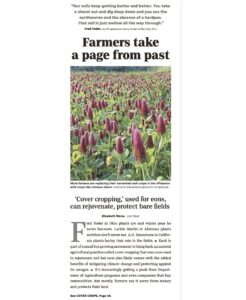Bloomberg's Leah Nylen reported Thursday that "a Colorado judge issued an order temporarily blocking the proposed $25 billion merger of Kroger Co. and Albertsons Cos., which has been challenged by…
Small Towns and Wind Farms, Energy Policy in Focus; While Cover Crops Garner Attention
David Gelles reported on the front page of today’s New York Times that, “Depressed property values. Flickering shadows. Falling ice. One by one, a real estate appraiser rattled off what he said were the deleterious effects of wind farms as a crowd in an agricultural community in central Illinois hung on his every word.
“It was the tenth night of hearings by the Piatt County zoning board, as a tiny town debated the merits of a proposed industrial wind farm that would see dozens of enormous turbines rise from the nearby soybean and corn fields. There were nine more hearings scheduled.
“‘It’s painful,’ said Kayla Gallagher, a cattle farmer who lives nearby and is opposed to the project. ‘Nobody wants to be here.'”
Gelles explained that, “In the fight against global warming, the federal government is pumping a record $370 billion into clean energy, President Biden wants the nation’s electricity to be 100 percent carbon-free by 2035, and many states and utilities plan to ramp up wind and solar power.

“But while policymakers may set lofty goals, the future of the American power grid is in fact being determined in town halls, county courthouses and community buildings across the country.
The only way Mr. Biden’s ambitious goals will be met is if rural communities, which have large tracts of land necessary for commercial wind and solar farms, can be persuaded to embrace renewable energy projects. Lots of them.
Today’s article explained that, “According to an analysis by the National Renewable Energy Laboratory, the United States would need to construct more than 6,000 projects like the Monticello one in order to run the economy on solar, wind, nuclear or other forms of nonpolluting energy.
“In Piatt County, population 16,000, the project at issue is Goose Creek Wind, which has been proposed by Apex Clean Energy, a developer of wind and solar farms based in Virginia. Apex spent years negotiating leases with 151 local landowners and trying to win over the community, donating to the 4-H Club and a mental health center.
“Now, it was making its case to the zoning board, which will send a recommendation to the county board that will make a final call on whether Apex can proceed. If completed, the turbines, each of them 610 feet tall, would march across 34,000 acres of farmland.”
The Times article pointed out that, “‘Projects have been getting more contentious,’ said Sarah Banas Mills, a lecturer at the school for environment and sustainability at the University of Michigan who has studied renewable development in the Midwest. ‘The low hanging fruit places have been taken.'”
Elsewhere, Elizabeth Weise reported on the front page of today’s USA Today that, “Fred Yoder in Ohio plants rye and winter peas he never harvests. Larkin Martin in Alabama plants radishes she’ll never eat. A.G. Kawamura in California plants barley that rots in the fields.
Each is part of a small but growing movement to bring back an ancient agricultural practice called cover cropping that was once used to rejuvenate soil but now also likely comes with the added benefits of mitigating climate change and protecting against its ravages.
“It’s increasingly getting a push from Department of Agriculture programs and even companies that buy commodities. But mostly, farmers say it saves them money and protects their land.”

Today’s article noted that, “Cover cropping is no panacea to the struggles farmers face as they operate within the razor-thin margins of agriculture. It can be costly – as much as $35 an acre – and takes several years to make a significant difference. It also requires new timing and sometimes new equipment and can increase pest infestations.
“But after a few years, fields planted in cover crops store thousands more gallons of water than bare fields during torrential rains, resist weeds’ encroachment more, hold together better against erosion, survive droughts better and capture more carbon in their soils.
“Increasingly, farmers are turning to it as a way to protect against erratic weather and to decrease costs from chemical inputs. The hope, eventually, is that these climate-smart crop practices might get a premium in the marketplace, reimbursing farmers for the climate work their fields do for the nation by returning carbon to the soil.”
Weise added that, “Ten years ago, only about 10 million acres in the U.S. were planted with cover crops. Today that’s up to about 22 million, and the number is increasing by about 8% annually, said Rob Myers, director of the Center for Regenerative Agriculture at the University of Missouri.
“A study last month by researchers at the University of Illinois found that in the Midwest, cover-cropped acreage increased fourfold from 2011 to 2021.”





